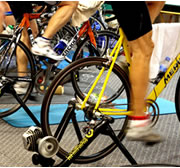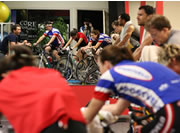All SportVelo athletes should have a trainer for foul weather workouts and warming up or cooling down for races. With the beginning of fall and winter weather right around the corner, I have several tips and suggestions for riding your stationary trainer.
 All SportVelo athletes should have a trainer for foul weather workouts and warming up or cooling down for races. With the beginning of fall and winter weather right around the corner, I have several tips and suggestions for riding your stationary trainer. Even though you may think that you can ride indoors the same way that you ride outside, you should take special considerations for your indoor, stationary workouts. Trainer workouts are not just a refuge from bad weather, so you can use them year-round—but sparingly. Mentally, they can be tough—but boring! Trainer workouts are more efficient, and so if you are already short on time, you will probably get a more intense workout in a shorter period of time than on the road. Additionally, they are a great way to work on form at any time during the year, especially for a great technique-specific recovery workout.
All SportVelo athletes should have a trainer for foul weather workouts and warming up or cooling down for races. With the beginning of fall and winter weather right around the corner, I have several tips and suggestions for riding your stationary trainer. Even though you may think that you can ride indoors the same way that you ride outside, you should take special considerations for your indoor, stationary workouts. Trainer workouts are not just a refuge from bad weather, so you can use them year-round—but sparingly. Mentally, they can be tough—but boring! Trainer workouts are more efficient, and so if you are already short on time, you will probably get a more intense workout in a shorter period of time than on the road. Additionally, they are a great way to work on form at any time during the year, especially for a great technique-specific recovery workout.
In general, there are four types of stationary trainers for your bike:
- Rollers were the first stationary trainers. Although now some offer resistance and a rack to secure your bike, the best use of rollers is without resistance and without the rack. Use rollers to work on technique, balancing, and your aerobic system. However, rollers aren’t best for high intensity training. Rollers are also great for competition warm-ups and cool downs. They emphasize your aerobic system and demand great, fluid pedaling form.
- A Mag trainer offers a linear resistance and typically has “click” to adjust the resistance. These trainers do not mimic the road like Fluid trainers, but they can be beneficial because at a lower setting, they do not “load up” your legs.
- Fluid trainers offer a feel that is very similar to the road, with a curvilinear resistance that gets exponentially more difficult as you pedal harder. The heavier the fly wheel, the better they mimic the feel of the road.
- CompuTrainers are a sophisticated, computer-controlled, stationary trainer available for cyclists. This type of trainer allows you to train by wattage, simulated terrain, and even drafting. You can program specific courses or tests into the CompuTrainer. Good brands include Blackburn , CycleOps, Elite, Kinetic, Kreitler, Magura, and Tacx.In addition to the trainer that you choose, you should also have at least one fan. You should control the intensity of a large, powerful fan, which you can turn up or down, and point directly at your body. If you have a CompuTrainer, Mag trainer, or Fluid trainer, ideally you should have a second, smaller fan, which you point directly at the mechanism to cool it as you ride your trainer, because these trainers tend to overheat and lose efficiency over their lifetime.Lastly, use a hard, properly inflated (max pressure) tire. Stationary trainers eat up tires, so it’s best to use an inexpensive, hard rubber tire. Don’t use your race tires.
Riding your Trainer
 In most respects, riding indoors is more difficult than riding outdoors. Not only can it be vastly more boring for longer periods of time because you don’t have the benefits of changing terrain and scenery and the challenges of your riding partners, but also, it’s far more efficient than riding outside. You don’t have the interruptions and distractions of traffic, lights, and downhills.
In most respects, riding indoors is more difficult than riding outdoors. Not only can it be vastly more boring for longer periods of time because you don’t have the benefits of changing terrain and scenery and the challenges of your riding partners, but also, it’s far more efficient than riding outside. You don’t have the interruptions and distractions of traffic, lights, and downhills.
Efficiency is good when you are short on time (but remember: bike racing happens outside, so please do the majority of your training outside, if possible!). However, such intensity poses a couple problems. For example, because you don’t have the benefit of the cushion of the road, make sure that you get out of the saddle frequently, for example, 15-60 seconds at least every 10-15 minutes.
Because of the more efficient conditions, you probably need no more than 60 minutes to work out on your trainer, and 90 minutes is considered long. Two hours on the trainer is heroic, but even 45 minutes can be time well spent. Keep in mind that indoor training requires more mental work than outdoors. Indoors requires so much more focus that most athletes “burn out” faster on indoor workouts than outdoor workouts, so please use your indoor time efficiently and sparingly (and use lots of good distractions, like music and DVDs.) Except for specific technique training (and really awful weather), I much prefer to see athletes biking on the road. As with your outdoor training, use part of your training time to warm up and cool down for at least 10 minutes each.
Additionally, many of us don’t realize how much water we need when we are outside, and you may need even more when you ride indoors. (if the room isn’t humid when you start, it probably will be when you are finished!) Now is a good time to make use of your scale: weigh yourself before you ride and after you ride, and make sure that you hydrate to make up the difference. In general, you should still have about one water bottle an hour, plus ~200 calories minimum on the bike, just as if you were outside, and more if the room where you work out is hot and gets humid while you train.